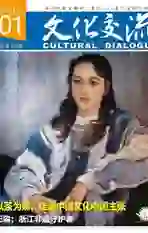陈望道:《共产党宣言》首个中文全译本翻译者
2018-01-09梁凉
梁凉
2017年10月31日,在党的十九大胜利闭幕一周之际,习近平总书记带领中共中央政治局常委专程赶赴上海瞻仰中共一大会址,赴浙江嘉兴瞻仰南湖红船。
上海兴业路76号,绿荫下的中共一大会址,花木扶疏,大门上的铜环熠熠生辉。青色砖墙、红色窗棂、精致条桌、雕花茶杯、粉色花瓶……1920年9月印刷出版的《共产党宣言》中文译本,静静地安放于展厅陈列柜。习近平总书记凝视着、思索着。他讲述了陈望道在翻译《共产党宣言》时“蘸着墨汁吃粽子,还说味道很甜”。
真理的味道如此甘甜,一代代共产党人前仆后继。讲解员说起这一《共产党宣言》译本由一位共产党人的老父亲放在衣冠冢中方才保存下来,总书记听了连称很珍贵,说这些文物是历史的见证,要保存好、利用好。
柴房中诞生《共产党宣言》第一个中文全译本
这本具有划时代意义的《共产党宣言》中文全译本,就是陈望道先生翻译的。《共产党宣言》是马克思、恩格斯所著国际共产主义运动第一个最重要纲领性文献,内容博大精深,表述文采飞扬,要翻译这部经典著作,译者起码得具备三个条件:对马克思学说有深入的了解;至少得精通一门外语;要有很高的汉语言文学素养。这样,才有可能把这部经典著作译得准确无误。
应上海《星期评论》社的约请,陈望道担负起了这个重任。1920年早春,他悄然回到故乡义乌,开始秘密翻译工作。为了躲避敌人的搜捕,他避开亲友邻居,躲在老家柴屋里,在泥地上铺几捆稻草,一块铺板搁在两条长板凳上,既当书桌又当床,专心致志地投入翻译工作之中。陈望道依据《共产党宣言》日译本、英译本,并借助《日汉辞典》和《英汉辞典》进行翻译。
陈望道出生在浙江义乌分水塘村。1915年起赴日本留学,先后在东洋大学、早稻田大学和中央大学学习文学、哲学、法律等,后获中央大学法学学士。1919年五四运动爆发后,陈望道回国到浙江省立第一师范学校任教。在这里他与夏丏尊、刘大白等教师发起国文改革,提倡思想解放,选用鲁迅《狂人日记》作为教材,强烈抨击旧文化;同时,支持学生施存统、宣中华创办《浙江新潮》刊物。反动当局将其视为洪水猛兽,责令校方查办施存统、陈望道等,从而爆发了著名的“一师风潮”。陈望道被迫离开学校。从一师的教学楼里走出来,陈望道意识到,要对旧制度进行根本的改革,必须有一个更高的辨别准绳。这个准绳便是马克思主义。
早春時节,浙中山区的气候还相当寒冷,常常使陈望道冻得手足发麻。他的母亲见儿子关起门来不分昼夜地写作,人都累瘦了,有一天便给儿子做了糯米粽子,外加一碟红糖,送到书桌前,催促儿子趁热快吃。陈望道一边吃粽子,一边继续琢磨翻译语句。母亲在屋外喊:“红糖够不够,要不要我再给你添些?”儿子应声答道:“够甜,够甜的了!”谁知,母亲前来收拾碗筷时,竟见到儿子满嘴是墨汁,红糖却一点儿没动,原来他是在专注的翻译中,错把墨汁当红糖,蘸了墨汁吃粽子,于是母子俩相对大笑一场。就这样,经过一百多天的苦战,在这间简陋的柴屋里,陈望道完成了马克思主义经典著作《共产党宣言》的翻译工作。墨汁为什么如此甘甜?这种真理的味道,只有真正的共产党人才能体会到。
一位共产党员的父亲在衣冠冢中保存珍贵译本
1920年8月,《共产党宣言》在上海被列为社会主义研究小丛书第一种出版发行,首印1000册,很快销售一空,9月份又印了1000册;到1926年5月,该书已出版至第17版。陈望道对于宣传马克思主义、推动中国共产党的创立起了非常重要的作用。陈望道、分水塘,也因此在历史的长河中留下了深深的印记。
这本1920年9月印刷出版的《共产党宣言》中文译本,是由一位共产党人的老父亲放在衣冠冢中保存下来的。这位共产党人叫张人亚。张人亚原名张守和,字静泉,“人亚”是他参加革命后用的名字。
1898年,张人亚出生在宁波镇海霞浦镇,16岁时来到上海,在老凤祥银楼当金银首饰制作工人。1921年加入共产党。
1927年4月,蒋介石发动“四·一二”反革命政变,白色恐怖笼罩上海。张人亚想到党的文件和马克思主义书刊的安危。经过再三考虑,1928年冬,张人亚秘密回到老家,将手中的文件书刊嘱托父亲张爵谦秘密保管。张爵谦是个普通农民,但生性耿直,机智勇敢,对革命有觉悟,对儿子的革命工作很支持。他先是把这包东西藏在自家菜园里。隔了几天,他向邻居佯称:不肖二儿子静泉长期在外不归,又毫无音信,恐怕早已死了。接着为二儿子和他早逝的妻子修建了一座合葬墓穴。张人亚一侧的墓穴是衣冠冢,放置的是空棺。张爵谦就将文件书刊用好几层油纸包扎好,藏进空棺埋入墓内。
张人亚为革命工作四处奔波。1932年12月23日,张人亚带病从江西瑞金赴长汀检查工作,途中因旧疾复发,无法救治殉职,年仅34岁。直到2005年,张人亚的亲属才得知张人亚的下落。而在这之前,苦等儿子归来的张爵谦,一直守着秘密。1950年,已到耄耋之年的张爵谦打开衣冠冢,将文件书刊取出来,并把三儿子张静茂从上海叫回浙江镇海霞浦老家,向他讲述了20多年前的这个秘密,嘱咐他把这些文件书刊带回上海,一定要交给党组织。张静茂遵嘱完成了这件大事,了却了老父亲20年来的心愿。
如今,这批文物分别由中央档案馆、国家博物馆和中共一大会址纪念馆珍藏。其中包括由陈望道翻译的《共产党宣言》。
为中国的文化教育事业作出了重大贡献
除《共产党宣言》外,陈望道还翻译了《空想的和科学的社会主义》一书,以及《马克思底唯物史观》《唯物史观底解释》等许多介绍、研究马克思主义新思潮的文章。陈望道参与了中国共产党的建党工作。1921年中国共产党成立后,他是党的上海地方委员会的第一任书记。 endprint
endprint
陳望道作为著名思想家、政治活动家,他的贡献是卓越的;作为学者、教育家和语言学家,他在学术上的成就,同样为世人瞩目。早在“五四”时期,陈望道便成为国内最早提倡使用新式标点的学者之一。从上世纪20年代始,他陆续撰写了《作文法讲义》《因明学》《美学概论》等著作,在逻辑学、美学、修辞学等多个领域均有独到的研究。在复旦大学等校任教期间,开设修辞学课程,编了教材并不断加以修订。上世纪30年代初,他潜心撰写出版《修辞学发凡》一书,这是中国第一部系统兼顾文言文和白话文的修辞学专著,奠定了现代修辞学的基础,被后人誉为里程碑式的著作。
陈望道是复旦大学在中华人民共和国成立后的第一任校长,他担任复旦大学校长达25年,是这一世界名校任期最长的校长。在大学校长生涯中,他倡导科研和新学风,主持修订《辞海》,为中国的文化教育事业作出了重大贡献。
1977年10月29日,陈望道病逝于上海,享年86岁。1980年1月23日,在他翻译《共产党宣言》60年以后,中共上海市委组织部根据党中央批示精神,在上海市革命公墓,为陈望道骨灰盒覆盖上中国共产党党旗,仪式隆重而又庄严。
Chen Wangdao First Translated Communist Manifesto into Chinese
By Liang Liang
On October 31, 2017, Xi Jinping, general secretary of the Communist Party of China Central Committee, who is also Chinese president and chairman of the Central Military Commission, and other members of the Standing Committee of the Political Bureau of the CPC Central Committee, visited the site of the First National Congress of the CPC held in 1921 in Shanghai. In one of the display cabinets at the site is a copy of Chinese version of printed in September 1920. Seeing the historical document in the cabinet, Xi Jinping mentioned the name of translator Chen Wangdao and told his colleagues a famous anecdote about the translators total absorption into translating that he dipped the food into ink and ate it without knowing.
Chen Wangdao (1891-1977) was the translator who translated the first complete Chinese version of , a historical document that changed China.
Chen was born into a farmers family in Fengshuitang, a village in Yiwu, Zhejiang. He went to Japan in 1915. He studied literature, philosophy and law at Toyo University, Waseda University and Chuo University and acquired a law degree at Chuo University. He came back home and taught at Zhejiang First Normal School in Hangzhou.
In the early spring of 1920, he was commissioned by Shanghai-based Weekly Review to translate into Chinese. The weekly wanted to serialize the document but didnt know where to find a qualified translator. Chen Wangdao was recommended: he was knowledgeable about Marxism, he had mastery of a foreign language, and he was a proficient Chinese writer. Chen accepted the mission and went to the home village to do the job. He shut himself up in the firewood storage hut and avoided seeing any neighbors and relatives. Her mother brought food to the hut. A simple wood plank propped up by two benches served as both a makeshift bed and desk. What he had were Japanese and English versions of the historical document and two dictionaries. It took him over 100 days to complete the translation.endprint
Weekly Review went out of business in June 1920 before the translation could be printed. The manuscript was later handed over to Chen Duxiu, who became the first general sectary of the Communist Party in 1921. Reading the translation overnight, Chen asked Li Hanjun, also a communist, to check the translation against an English version. In August 1920, Chen Wangdaos translation was printed in Shanghai. The first run was 1,000 copies. It soon sold out. The reprint in September was 1,000 copies. By May 1926 it had been reprinted 17 times.
The copy at the Shanghai site was preserved by Zhang Jueqian, a farmer and father of a communist. His son was Zhang Renya, born in Xiapu Town, Zhenghai, Ningbo in eastern Zhejiang. Zhang Renya came to Shanghai at 16 to be an apprentice. He joined the Chinese Communist Party in 1921. In April 1927, Chiang Kai-shek broke the cooperation with the Communist Party and massacred communists. In the winter of 1928, Zhang Renya came home secretly and asked his father to look after a bundle of the Partys documents and Marxist publications. The father buried the bundle in the vegetable garden. A few days later, he told his neighbors that he worried his son had probably died a long time before. The father built a tomb for the son and sons wife who had really passed away a long time ago. In the coffin meant for the son, Zhang Jueqian put in the bundle wrapped in layers of oiled paper and sealed the tomb.
Zhang Renya died in December 1932 as a revolutionary, but it was not until 2005 that the family first received the information. The father kept the secret. In his evening years, he thought it was important to get the buried bundle out. He opened the coffin in 1950, after the founding of the Peoples Republic in 1949. He summoned his third son Zhang Jingmao back from Shanghai and told him the secret he had kept for over 20 years. The father asked the son to take the bundle to Shanghai and hand it over to the government.
Today, the documents and Marxist publications are separately housed at the Central Archives, National Museum in Beijing and the Memorial Museum of the Site of the First National Congress of the Chinese Communist Party in Shanghai.
Chen served as president of Fudan University for 25 years, from 1949 to 1977 when he passed away at the age of 86. On January 23, 1980, a ceremony was held at Shanghai Revolutionary Cemetery. The box that contained the ashes of Chen Wangdao was solemnly wrapped up with a flag of the Chinese Communist Party before it was put back to the tomb.endprint
